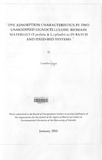| dc.description.abstract | Industrial dye wastewater is a major environmental concern ill developing
countries. This study investigated the viability of two low cost adsorbents
(L.cylindrica, T.pedata and their mixture) in the adsorption of color from colored
industrial effluent through experimenting with dyes.
The batch and fixed-bed modes of operation were utilized on the adsorbents
while varying the adsorbate between Methylene blue and Congo red. The
influence of different experimental parameters such as contact time, dye
concentration, adsorbent dose, pH, temperature and ionic strength were studied
in the batch mode.
Observations revealed that for maximum %adsorption of Methylene blue dye, a
contact time of 30 minutes, 5 minutes and 55 minutes was required for
L.cylindrica, T.pedata, and their equal weight mixture to achieve 99%, 97% and
100%adsorption, respectively. The optimum dye concentration was found to be
the lowest concentration used (i.e., 1.0x10-<6"tv1).The plant materials adsorbed
100% of the dye at this lowest concentration. The highest % adsorption was
recorded when the maximum adsorbent dose of 3g was used for L.cylindrica and
the mixture, at 99%and 100%,respectively. However, T.pedata removed the most
dye with the least amount of adsorbent employed (0.5g). The % adsorption in
this case was 99%.The optimum pH and temperature was found to be pH 10and
20oe,respectively for all the three types of adsorbents investigated. Observations
made regarding the effect of temperature led to the conclusion that the
adsorption process was exothermic. This further indicated that the ratedetermining
step of the adsorption process was intra-particle mass transfer. The
% adsorption was found to be inversely proportional to ionic strength of
solution. With Congo red dye employed as a representative acidic dye, the
optimum contact time was observed to be at 120minutes. 96%was recorded with
L.cylindrica, while 57% and 76% was recorded with T.pedata, and the mixture,
respectively. Similarly, the lowest concentration of dye used resulted in the
highest %adsorption recorded: L.cylindrica, 84%,T.pedata, 39%and mixture, 61%.
It was observed that at 3g, which was the highest adsorbent dose employed,
L.cylindrica, T.pedata and the mixture adsorbed the most dye which varied in %
adsorption as 83%, 48% and 65%, respectively. The optimum temperature was
200C pH studies revealed that L.cylindrica adsorbed best at pH 6.9 (78%),T.pedata
at pH 3.82 (77%),and the mixture at pH 5 (57%).Observations made on effect of
ionic strength revealed that when 9.5x10-4MKCl was added to the dye solution,
L.cylindrica and the mixture had the highest % adsorptions of 89% and 86%,
respectively. However, T.pedata resulted in 96%adsorption; the highest recorded,
after 4.0X10-3M ofKG was added. Adsorption Isotherm studies indicated that
the Freundlich model gave a better fit to the experimental data than the
Langmuir equation.
Two parameters were investigated for the fixed bed mode of operation.
Investigations on the effect of influent dye concentration with L.cylindrica
showed breakthrough point at the volume of 2400rnl and 5000rnl, for 1.OxlO-5M
and 5.0x1G-6M, respectively. The breakthrough point for T.pedata was at the
volume of 1200 ml and 1500 ml, at dye concentrations of 1.0x10-5M and 5.0x10-6
M respectively. Further experiments on the effect of adsorbent dose showed the
breakthrough point of L.cylindrica to be at 2500rnl and 5000 rnl, when 2.5 g and
5 g of adsorbent were used, respectively. Breakthrough for T.pedata was observed
at 1000 ml and 1900 ml, when 2.5 g and 5 g of plant material were used,
respectively. | en |

